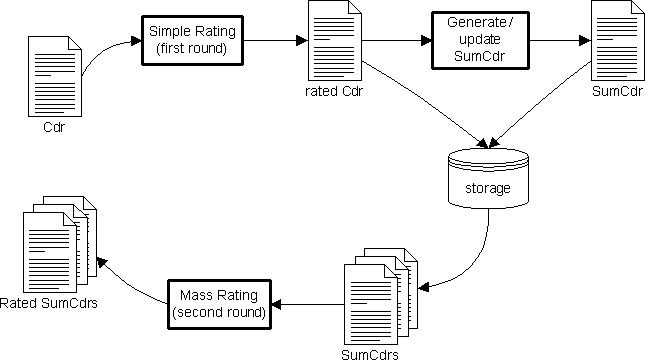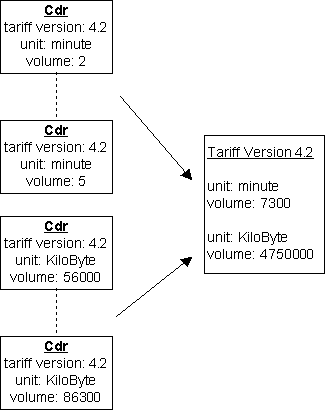
Settlement's RatingSettlement's rating meaning the rating process performed for interconnect settlement purposes. The parties involves are the network carriers. Rating for carriers involves large volume of traffic sending in and out of their networks. The settlement's rating should be designed in such a way that it will rate the total traffic transfered between networks instead of the small volume in every individual call. |

Settlement rating is divided into two parts. First round rating will be performed on a per Cdr basis. Each settlement interested Cdr, generated from a network usage will be passed into a tariff system for the first round rating. Each used services in the Cdr will be rated to get its Tariff Class and Tariff Period and other information. These infos are stored in Cdr for later use.
SumCdr is generated from the information contained in the rated call details records. Each SumCdr is generated based on several levels of grouping criteria. For example, based on contract, product, service, tariff period, etc. The final grouping criteria, and the mandatory grouping criteria is the tariff version applicable. As shown in diagram , SumCdr contains a tariff version and a list of volume/unit pairs. The list of volume/unit pairs are the total of the grouping rated Cdrs.

Generation or update of a SumCdr can be performed based on two basis. First approach is to perform the update or creation after a certain amount of rated Cdrs are available (have been rated). Second approach is to perform the updating or creation of SumCdrs for every block of time. For example, every 15 minutes.
All SumCdrs and settlement interested Cdrs should be stored in such a way that it can be retrieved easily. SumCdrs and rated Cdrs will be retrieved for further processing. They are selected base on the contracts they assigned to. All SumCdrs and selected rated Cdrs must be sorted with the time stamp information they contained. The process of grouping and sorting can be carried out on batch basis when the queue reaches a certain limit or on a daily basis.
In billing, second round rating will be started to complete the rating process for settlement. Input for this second round rating involves SumCdrs. Instead of getting another object to rate a SumCdr, the SumCdr itself, will have a function that will perform the rating process. This function wiil take in a tariff catalogue, thus to get the tariff version this SumCdr required, then apply the rating. The result, applicable cost, will be written back to the SumCdr also.